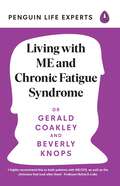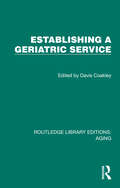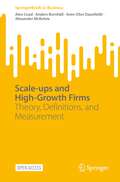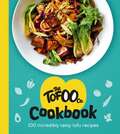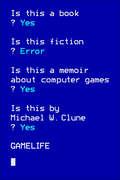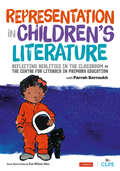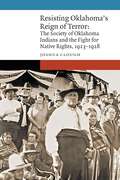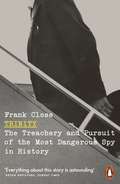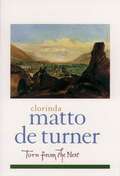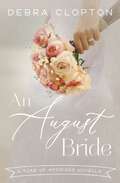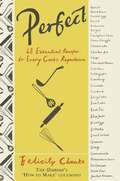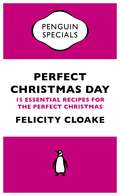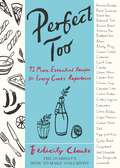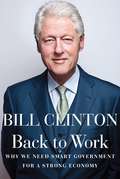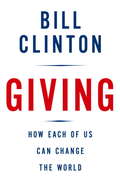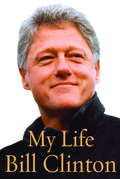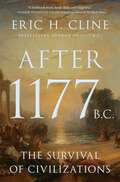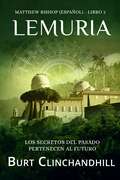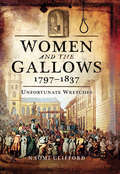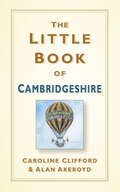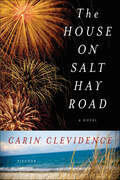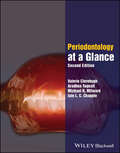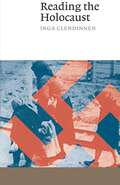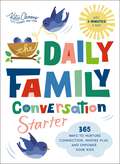- Table View
- List View
Living with ME and Chronic Fatigue Syndrome (Penguin Life Expert Series #6)
by Dr Gerald Coakley Beverly KnopsChronic fatigue conditions are some of the most frustrating, life-altering and stigmatized illnesses, so why are they still so poorly understood?ME/CFS affects roughly 17 million people worldwide. Medicalscience still cannot explain why some people get chronic fatigue syndromes and, distressingly, there are few effective treatments. While many people with ME/CFS are able to live a fairly normal life, a significant minority have symptoms so severe that they are confined to their house, or even their bed, and suicide rates are well above the national average.Living with ME and Chronic Fatigue Syndrome, by consultant rheumatologist Dr Gerald Coakley and occupational therapist Beverly Knops, is a much-needed, evidence-based guide for people struggling with ME/CFS - as well as their friends and family - that provides practical information and accessible advice on how to manage and live with this challenging condition, at all stages of severity. It will explore:- The causes and management options for ME/CFS- The impact of the condition on work, education and emotional wellbeing- The importance of a balanced, nutritious diet in managing your symptoms- Post-Viral Fatigue Syndrome (PVFS) and other fatigue-related syndromes- Advice for carers and questions to ask your doctor- Life after ME/CFS This essential, concise book, and its empowering patient stories of hope, will equip readers with the knowledge, strategies and support to navigate and manage this challenging condition.
Establishing a Geriatric Service (Routledge Library Editions: Aging)
by Davis CoakleyBy the early 1980s, industrialised countries had experienced a dramatic increase in the number of people who survive into old age. The provision of a high standard of health care for these elderly citizens is one of the major challenges facing health services throughout the world.Originally published in 1982, in this book experts describe the geriatric services in Britain at the time, a country which had pioneered developments in this field over the previous thirty years. Much of the practical knowledge required to establish a service is outlined and the underlying philosophy is also discussed. The material covered includes the historical development of the services, operational policies, the team approach, orthopaedic and psychiatric services for the elderly and the social aspects of care. There is also a chapter dealing with the importance of education and research in this field.Unique in its approach, this book would have been of considerable value to those seeking to establish a geriatric service or to improve an already established service. Today it can be read in its historical context.
Scale-ups and High-Growth Firms: Theory, Definitions, and Measurement (SpringerBriefs in Business)
by Alex Coad Anders Bornhäll Sven-Olov Daunfeldt Alexander McKelvieThis open access book goes into the details of the characteristics of scale-ups, touching upon various theoretical perspectives (stages of growth models, the role of intangible capital, the tradeoffs between fixed costs and marginal costs) relating to firm growth, to provide a clear definition of this emerging concept. Given the disproportionately large economic contribution of a small number of fast-growing firms, there has been growing interest in a category of dynamic ventures called "scale-ups". The term was popularized by Silicon Valley Venture Capitalists before receiving attention from academics and public policy makers. However, there remains considerable confusion regarding what a scale-up actually is.This is an open access book.
The Tofoo Cookbook: 100 delicious, easy & meat free recipes
by The Tofoo Co.There's so much you can do with Tofoo!Tear it, chop it, fry it, marinade it, dice it or slice it, tofu is the secret ingredient to delicious, hearty vegetarian eating. The Tofoo Cookbook is filled with 100 satisfying, uncomplicated and frankly delicious dishes for every taste.With easy to follow steps on prepping tofu, delicious marinades and tips for nailing the basics, this book is the perfect guide for anyone looking to add a little to-fun into their cooking. Including classics like Tofu Shakshuka, Tofish and Chips and Tofu Poke Bowls to exciting new recipes like Chipotle Tofu Tacos, Panko Tofu Bao Buns and Sumac Tofu with Tahini Sauce, this book is perfect for everyone from the most dedicated vegetarians to the reluctant flexitarian. From breakfast to brunch, speedy lunches to delicious dinners, this book has everything you need to create some tofu-riffic meals.
Gamelife: A Memoir
by Michael W. CluneIn telling the story of his youth through seven computer games, critically acclaimed author Michael W. Clune (White Out) captures the part of childhood we live alone. You have been awakened.Floppy disk inserted, computer turned on, a whirring, and then this sentence, followed by a blinking cursor. So begins Suspended, the first computer game to obsess seven-year-old Michael, to worm into his head and change his sense of reality. Thirty years later he will write: "Computer games have taught me the things you can't learn from people."Gamelife is the memoir of a childhood transformed by technology. Afternoons spent gazing at pixelated maps and mazes train Michael's eyes for the uncanny side of 1980s suburban Illinois. A game about pirates yields clues to the drama of cafeteria politics and locker-room hazing. And in the year of his parents' divorce, a spaceflight simulator opens a hole in reality.
Representation in Children′s Literature: Reflecting Realities in the classroom
by CLPEThe under-representation of characters of colour in children′s literature in the UK is quantified in the CLPE′s award winning Reflecting Realities research.Through this research, the CLPE actively disrupts the demand-and-supply chain and holds the children′s publishing industry to account, encouraging it to do better. This book: * explores what Reflecting Realities teaches us; * empowers teachers to take positive to ensure classroom libraries are truly representative; * takes time to reflect on the research; * enables teachers to explore what constitutes quality representation; * includes practical support on how to translate this thinking into positive change in the classroom; * provides guidance for curating literature for young readers; * highlights how engagement with inclusive literature positively impacts school reading cultures and wider teaching and learning.
Representation in Children′s Literature: Reflecting Realities in the classroom
by CLPEThe under-representation of characters of colour in children′s literature in the UK is quantified in the CLPE′s award winning Reflecting Realities research.Through this research, the CLPE actively disrupts the demand-and-supply chain and holds the children′s publishing industry to account, encouraging it to do better. This book: * explores what Reflecting Realities teaches us; * empowers teachers to take positive to ensure classroom libraries are truly representative; * takes time to reflect on the research; * enables teachers to explore what constitutes quality representation; * includes practical support on how to translate this thinking into positive change in the classroom; * provides guidance for curating literature for young readers; * highlights how engagement with inclusive literature positively impacts school reading cultures and wider teaching and learning.
Resisting Oklahoma's Reign of Terror: The Society of Oklahoma Indians and the Fight for Native Rights, 1923–1928 (New Visions in Native American and Indigenous Studies)
by Dr. Joshua CloughThe oil and natural gas boom in pre–World War I Oklahoma brought unbelievable wealth to thousands of tribal citizens in the state on whose lands these minerals were discovered. However, as Angie Debo recognizes in her seminal study of the period, And Still the Waters Run, and, more recently, as David Grann does in Killers of the Flower Moon, this affluence placed Natives in the crosshairs of unscrupulous individuals. As a result, this era was also marked by two of the most heinous episodes of racial violence in the state&’s history: the Tulsa Race Massacre of 1921 and the Osage Murders between 1921 and 1925. In Resisting Oklahoma&’s Reign of Terror Joshua Clough details the responses of one largely forgotten Native organization—the Society of Oklahoma Indians (SOI)—to the violence and pillaging of tribal resources during the 1920s. Clough provides historical understanding of its formation and its shared values of intertribal unity, Native suffrage, and protection of Native property. He also reveals why reform efforts were nearly impossible in 1920s Oklahoma and how this historical perspective informs today&’s conflicts between the state and its Indigenous inhabitants. Through this examination of the SOI, Clough fills the historiographic gap regarding formal Native resistance between the dissolution of the national Society of American Indians in 1923 and the formation of the National Congress of American Indians in 1944. Dismissed or overlooked for a century as an inconsequential Native activist organization, the history of the SOI, when examined carefully, reveals the sophistication and determination of tribal members in their struggle to prevent depredations on their persons and property.
Trinity: The Treachery and Pursuit of the Most Dangerous Spy in History
by Frank Close'Everything about this story is astounding' Bryan Appleyard, Sunday Times"Trinity" was the codename for the test explosion of the atomic bomb in New Mexico on 16 July 1945. Trinity is now also the extraordinary story of the bomb's metaphorical father, Rudolf Peierls; his intellectual son, the atomic spy, Klaus Fuchs, and the ghosts of the security services in Britain, the USA and USSR.Against the background of pre-war Nazi Germany, the Second World War and the following Cold War, the book traces how Peierls brought Fuchs into his family and his laboratory, only to be betrayed. It describes in unprecedented detail how Fuchs became a spy, his motivations and the information he passed to his Soviet contacts, both in the UK and after he went with Peierls to join the Manhattan Project at Los Alamos in 1944. Frank Close is himself a distinguished nuclear physicist: uniquely, the book explains the science as well as the spying.Fuchs returned to Britain in August 1946 still undetected and became central to the UK's independent effort to develop nuclear weapons. Close describes the febrile atmosphere at Harwell, the nuclear physics laboratory near Oxford, where many of the key players were quartered, and the charged relationships which developed there. He uncovers fresh evidence about the role of the crucial VENONA signals decryptions, and shows how, despite mistakes made by both MI5 and the FBI, the net gradually closed around Fuchs, building an intolerable pressure which finally cracked him.The Soviet Union exploded its first nuclear device in August 1949, far earlier than the US or UK expected. In 1951, the US Congressional Committee on Atomic Espionage concluded, 'Fuchs alone has influenced the safety of more people and accomplished greater damage than any other spy not only in the history of the United States, but in the history of nations'. This book is the most comprehensive account yet published of these events, and of the tragic figure at their centre.
Torn From The Nest (Library Of Latin America Ser.)
by Clorinda. Matto de Turner John Polt Antonio Cornejo PolarClorinda Matto de Turner was the first Peruvian novelist to command an international reputation and the first to dramatize the exploitation of indigenous Latin American people. She believed the task of the novel was to be the photograph that captures the vices and virtues of a people, censuring the former with the appropriate moral lesson and paying its homage of admiration to the latter. In this tragic tale, Clorinda Matto de Turner explores the relationship between the landed gentry and the indigenous peoples of the Andean mountain communities. While unfolding as a love story rife with secrets and dashed hopes,Torn from the Nestin fact reveals a deep and destructive class disparity, and criticizes the Catholic clergy for blatant corruption. When Lucia and Don Fernando Marin settle in the small hamlet of Killac, the young couple become advocates for the local Indians who are being exploited and oppressed by their priest and governor and by the gentry allied with these two. Considered meddling outsiders, the couple meet violent resistance from the village leaders, who orchestrate an assault on their house and pursue devious and unfair schemes to keep the Indians subjugated. As a romance blossoms between the a member of the gentry and the peasant girl that Lucia and Don Fernando have adopted, a dreadful secret prevents their marriage and brings to a climax the novel's exposure of degradation: they share the same father--a parish priest. Torn from the Nestwas first published in Peru in 1889 amidst much enthusiasm and outrage. This fresh translation--the first since 1904--preserves one of Peru's most distinctive and compelling voices.
An August Bride (A Year of Weddings Novella)
by Debra CloptonA year&’s worth of novellas from twelve inspirational romance authors. Happily ever after guaranteed.As far as Kelsey Wilcox is concerned, her last cowboy was the last cowboy. Kelsey Wilcox has had enough of cowboys. After the last one broke her heart, Kelsey traded in her boots for flip-flops, and the open range for a bistro on the beach. Her life on Corpus Christi&’s gorgeous beach might be a little lonely, but at least it&’s heartbreak-free. At least until her cousin&’s beachside wedding bucks Kelsey right back into the rodeo.When unlucky-in-love Brent Corbin packed his groomsman&’s tux for his friend&’s wedding, he brought his boots and belt buckle with him. Brent isn&’t exactly looking for love, but when he sees what appears to be a mermaid in distress, he jumps right in to rescue her. So Kelsey finds herself plucked from the sea—and certain-drowning—by a gorgeous groomsman . . . in soaked cowboy boots. She&’s quick to say thanks, but no thanks.Brent dedicates the weekend to pursuing Kelsey—and Kelsey spends the weekend trying to deny an obvious match. She&’s as stubborn as a wild horse, but Brent&’s determination may tame her yet.
Perfect: 68 Essential Recipes for Every Cook's Repertoire
by Felicity CloakeWhether you're a competent cook or have just caught the bug, Perfect has a place in every kitchen.Is there a foolproof way to poach an egg? What's the secret of perfect pastry? Could a glass of milk turn a good Bolognese into a great one?The Guardian's 'How to Make' food columnist Felicity Cloake is on a mission to find the perfect staple dishes - from spag bol to brownies to fish pie. Having rigorously tried and tested recipes from all the greats - including Elizabeth David, Delia Smith and Nigel Slater - Felicity has pulled together the best points from each to create the perfect version of 68 classic dishes.Never again will you have to rifle through countless different books to find the your perfect roast chicken recipe, mayonnaise method or that incredible tomato sauce - they're all here.'Brilliant . . . finely honed culinary instincts, an open mind and a capacious cookbook collection . . . Miss Cloake has them all' Evening Standard
Perfect Christmas Day: 15 Essential Recipes for the Perfect Christmas (Penguin Specials)
by Felicity CloakePenguin Specials are designed to fill a gap. Written to be read over a long commute or a short journey, they are original and exclusively in digital form.Christmas dinner is perhaps the one meal of the year where even the most relaxed cook feels the pressure of perfection - and, although few menus can be more familiar, it's probably the one we all feel the least confident about.Cooking Christmas dinner can be stressful, but there's no need to rifle through recipe books, or frantically Google turkey cooking times on Christmas morning as Felicity Cloake has tried and tested recipes from all the greats - from Nigella Lawson and Simon Hopkinson to Delia Smith and Mrs Beeton - and pulled together the best points from each to come up with the ultimate Christmas Day recipe collection. Based on Felicity's popular Guardian column, Perfect Christmas Day combines invaluable prepping and cooking tips to calm the most frazzled of festive souls and, of course, fifteen delicious recipes. From mulled wine, blinis, stilton soufflés and the perfect prawn cocktail to turkey and gravy, stuffing, sprouts, roast potatoes, pigs-in-blankets, nut roast, and cranberry and bread sauce, to trifle, mince pies and brandy butter, Perfect Christmas Day is all you need to prepare the perfect Christmas dinner.
Perfect Too: 92 More Essential Recipes for Every Cook's Repertoire
by Felicity CloakeHaving rigorously tried and tested recipes from all the greats - Elizabeth David and Delia Smith to Nigel Slater and Simon Hopkinson - Felicity Cloake has pulled together the best points from each to create the perfect version of 92 more classic dishes, from perfect crème brulee to the perfect fried chicken.Never again will you have to rifle through countless different books to find your perfect pulled pork recipe, Thai curry paste method or failsafe chocolate fondants - it's all here in this book, based on Felicity's popular Guardian columns, along with dozens of practical, time-saving invaluable prepping and cooking tips that no discerning cook should live without. Following on from the much-loved Perfect, Perfect Too has a place on every kitchen shelf.
Back to Work: Why We Need Smart Government for a Strong Economy
by Bill Clinton&“I wrote this book because I love my country and I'm concerned about our future,&” writes Bill Clinton. &“As I often said when I first ran for President in 1992, America at its core is an idea—the idea that no matter who you are or where you're from, if you work hard and play by the rules, you'll have the freedom and opportunity to pursue your own dreams and leave your kids a country where they can chase theirs.&” In Back to Work, Clinton details how we can get out of the current economic crisis and lay a foundation for long-term prosperity. He offers specific recommendations on how we can put people back to work and create new businesses, increase bank lending and corporate investment, double our exports, and restore our manufacturing base. He supports President Obama&’s emphasis on green technology, saying that change in the way we produce and consume energy is the strategy most likely to spark a fast-growing economy and enhance our national security. Clinton also says that we need both a strong economy and a smart government working together to restore prosperity and progress. He demonstrates that whenever we&’ve given in to the temptation to blame government for our problems, we&’ve lost our commitment to shared prosperity, balanced growth, financial responsibility, and investment in the future. That has led our nation into trouble because there are some things we have to do together. For example, he says, &“Our ability to compete in the twenty-first century is dependent on our willingness to invest in infrastructure: we need faster broadband, a state-of-the-art national electrical grid, modernized water and sewer systems, and the best airports, trains, roads, and bridges. &“There is no evidence that we can succeed in the twenty-first century with an antigovernment strategy,&” writes Clinton, &“with a philosophy grounded in &‘You&’re on your own&’ rather than &‘We&’re all in this together.&’&” Clinton believes that conflict between government and the private sector has proved to be remarkably good politics, but it has produced bad policies, giving us a weak economy with few jobs, growing income inequality and poverty, and a decline in our competitive position. In the real world, cooperation works much better than conflict, and &“we need victories in the real world.&”
Giving: How Each Of Us Can Change The World
by Bill ClintonHere, from Bill Clinton, is a call to action. Giving is an inspiring look at how each of us can change the world. First, it reveals the extraordinary and innovative efforts now being made by companies and organizations—and by individuals—to solve problems and save lives both “down the street and around the world.” Then it urges us to seek out what each of us, “regardless of income, available time, age, and skills,” can do to help, to give people a chance to live out their dreams.Bill Clinton shares his own experiences and those of other givers, representing a global flood tide of nongovernmental, nonprofit activity. These remarkable stories demonstrate that gifts of time, skills, things, and ideas are as important and effective as contributions of money. From Bill and Melinda Gates to a six-year-old California girl named McKenzie Steiner, who organized and supervised drives to clean up the beach in her community, Clinton introduces us to both well-known and unknown heroes of giving. Among them:Dr. Paul Farmer, who grew up living in the family bus in a trailer park, vowed to devote his life to giving high-quality medical care to the poor and has built innovative public health-care clinics first in Haiti and then in Rwanda;a New York couple, in Africa for a wedding, who visited several schools in Zimbabwe and were appalled by the absence of textbooks and school supplies. They founded their own organization to gather and ship materials to thirty-five schools. After three years, the percentage of seventh-graders who pass reading tests increased from 5 percent to 60 percent;'Oseola McCarty, who after seventy-five years of eking out a living by washing and ironing, gave $150,000 to the University of Southern Mississippi to endow a scholarship fund for African-American students;Andre Agassi, who has created a college preparatory academy in the Las Vegas neighborhood with the city’s highest percentage of at-risk kids. “Tennis was a stepping-stone for me,” says Agassi. “Changing a child’s life is what I always wanted to do”;Heifer International, which gave twelve goats to a Ugandan village. Within a year, Beatrice Biira’s mother had earned enough money selling goat’s milk to pay Beatrice’s school fees and eventually to send all her children to school—and, as required, to pass on a baby goat to another family, thus multiplying the impact of the gift.Clinton writes about men and women who traded in their corporate careers, and the fulfillment they now experience through giving. He writes about energy-efficient practices, about progressive companies going green, about promoting fair wages and decent working conditions around the world. He shows us how one of the most important ways of giving can be an effort to change, improve, or protect a government policy. He outlines what we as individuals can do, the steps we can take, how much we should consider giving, and why our giving is so important.Bill Clinton’s own actions in his post-presidential years have had an enormous impact on the lives of millions. Through his foundation and his work in the aftermath of the Asian tsunami and Hurricane Katrina, he has become an international spokesperson and model for the power of giving.“We all have the capacity to do great things,” President Clinton says. “My hope is that the people and stories in this book will lift spirits, touch hearts, and demonstrate that citizen activism and service can be a powerful agent of change in the world.”
My Life: My Life In The Colorful World Of New Jersey Politics
by Bill ClintonPresident Bill Clinton’s My Life is the strikingly candid portrait of a global leader who decided early in life to devote his intellectual and political gifts, and his extraordinary capacity for hard work, to serving the public. It shows us the progress of a remarkable American, who, through his own enormous energies and efforts, made the unlikely journey from Hope, Arkansas, to the White House—a journey fueled by an impassioned interest in the political process which manifested itself at every stage of his life: in college, working as an intern for Senator William Fulbright; at Oxford, becoming part of the Vietnam War protest movement; at Yale Law School, campaigning on the grassroots level for Democratic candidates; back in Arkansas, running for Congress, attorney general, and governor.We see his career shaped by his resolute determination to improve the life of his fellow citizens, an unfaltering commitment to civil rights, and an exceptional understanding of the practicalities of political life.We come to understand the emotional pressures of his youth—born after his father’s death; caught in the dysfunctional relationship between his feisty, nurturing mother and his abusive stepfather, whom he never ceased to love and whose name he took; drawn to the brilliant, compelling Hillary Rodham, whom he was determined to marry; passionately devoted, from her infancy, to their daughter, Chelsea, and to the entire experience of fatherhood; slowly and painfully beginning to comprehend how his early denial of pain led him at times into damaging patterns of behavior.President Clinton’s book is also the fullest, most concretely detailed, most nuanced account of a presidency ever written—encompassing not only the high points and crises but the way the presidency actually works: the day-to-day bombardment of problems, personalities, conflicts, setbacks, achievements.It is a testament to the positive impact on America and on the world of his work and his ideals.It is the gripping account of a president under concerted and unrelenting assault orchestrated by his enemies on the Far Right, and how he survived and prevailed. It is a treasury of moments caught alive, among them:• The ten-year-old boy watching the national political conventions on his family’s new (and first) television set.• The young candidate looking for votes in the Arkansas hills and the local seer who tells him, “Anybody who would campaign at a beer joint in Joiner at midnight on Saturday night deserves to carry one box. . . . You’ll win here. But it’ll be the only damn place you win in this county.” (He was right on both counts.)• The roller-coaster ride of the 1992 campaign.• The extraordinarily frank exchanges with Newt Gingrich and Bob Dole.• The delicate manipulation needed to convince Rabin and Arafat to shake hands for the camera while keeping Arafat from kissing Rabin.• The cost, both public and private, of the scandal that threatened the presidency.Here is the life of a great national and international figure, revealed with all his talents and contradictions, told openly, directly, in his own completely recognizable voice. A unique book by a unique American.
After 1177 B.C.: The Survival of Civilizations (Turning Points in Ancient History #12)
by Eric H. ClineIn this gripping sequel to his bestselling 1177 B.C., Eric Cline tells the story of what happened after the Bronze Age collapsed—why some civilizations endured, why some gave way to new ones, and why some disappeared forever&“A landmark book: lucid, deep, and insightful. . . . You cannot understand human civilization and self-organization without studying what happened on, before, and after 1177 B.C.&”—Nassim Nicholas Taleb, bestselling author of The Black SwanAt the end of the acclaimed history 1177 B.C., many of the Late Bronze Age civilizations of the Aegean and Eastern Mediterranean lay in ruins, undone by invasion, revolt, natural disasters, famine, and the demise of international trade. An interconnected world that had boasted major empires and societies, relative peace, robust commerce, and monumental architecture was lost and the so-called First Dark Age had begun. Now, in After 1177 B.C., Eric Cline tells the compelling story of what happened next, over four centuries, across the Aegean and Eastern Mediterranean world. It is a story of resilience, transformation, and success, as well as failures, in an age of chaos and reconfiguration.After 1177 B.C. tells how the collapse of powerful Late Bronze Age civilizations created new circumstances to which people and societies had to adapt. Those that failed to adjust disappeared from the world stage, while others transformed themselves, resulting in a new world order that included Phoenicians, Philistines, Israelites, Neo-Hittites, Neo-Assyrians, and Neo-Babylonians. Taking the story up to the resurgence of Greece marked by the first Olympic Games in 776 B.C., the book also describes how world-changing innovations such as the use of iron and the alphabet emerged amid the chaos.Filled with lessons for today's world about why some societies survive massive shocks while others do not, After 1177 B.C. reveals why this period, far from being the First Dark Age, was a new age with new inventions and new opportunities.
Lemuria (Matthew Bishop (Español) #2)
by Burt ClinchandhillLos secretos del pasado pertenecen al futuro. Cuando en todo el mundo desaparecen las últimas tribus vivas aisladas, el profesor Matthew Bishop se ve arrastrado de nuevo, sin quererlo, a una aventura que le llevará por todo el globo. Su interés personal aumenta cuando su íntima amiga Jennifer Porter desaparece y parece estar implicada de algún modo. Siguiendo las pistas ocultas, y con la ayuda del Vaticano y de viejos amigos, Bishop descubre la verdad sobre el siguiente paso en la evolución. Es una verdad que no termina en esta Tierra, sino que podría muy bien significar el final de ella, en un viaje a través de tres continentes y hacia los cielos. EVOLVED PUBLISHING PRESENTA el segundo libro de la serie "Matthew Bishop" de thrillers de conspiraciones religiosas, ideal para fans de Dan Brown y Michael Crichton.
Women and the Gallows, 1797–1837: Unfortunate Wretches
by Naomi CliffordThis true crime history of Georgian England reveals the scandalous lives—and unceremonious deaths—of more than 100 women who faced execution.In the last four decades of the Georgian era, 131 women were sent to the gallows. Unlike most convicted felons, none of them were spared by an official reprieve. Historian Naomi Clifford examines the crimes these women committed and asks why their grim sentences were carried out.Women and the Gallows, 1797–1837 reveals the harsh and unequal treatment women could expect from the criminal justice system of the time. It also brings new insight into the lives and the events that led these women to their deaths. Clifford explores cases of infanticide among domestic servants, counterfeiting, husband poisoning, as well as the infamous Eliza Fenning case.This volume also includes a complete chronology of the executed women and their crimes.
The Little Book of Cambridgeshire (Little Book Of)
by Caroline Clifford Alan AkeroydTHE LITTLE BOOK OF CAMBRIDGESHIRE is a compendium full of information which will make you say, ‘I never knew that!’ Contained within is a plethora of entertaining stories about the county and its famous - and occasionally infamous - men and women, its literary, artistic and sporting achievements, its customs and traditions, its transport and leisure, and a few ghostly appearances.Compiled by two knowledgeable local historians, this is a reliable reference book and a quirky guide, this can be dipped in to time and time again to reveal something new about the people, the heritage, the secrets and the enduring fascination of the county.
The House on Salt Hay Road: A Novel
by Carin ClevidenceA fireworks factory explodes in a quiet seaside town. In the house on Salt Hay Road, Clay Poole is thrilled by the hole it's blown in everyday life. His older sister, Nancy, is more interested in the striking stranger who appears, dusted with ashes, in the explosion's aftermath. The Pooles—taken in as orphans by their mother's family—can't yet know how the bonds of their makeshift household will be tested and frayed. As their aunt searches for signs from God and their uncle begins an offbeat courtship, they are pulled toward two greater cataclysms: the legendary hurricane of 1938 and the encroaching war.The House on Salt Hay Road is suffused with a haunting sense of place: salt marshes in the summer, ice boats on the frozen Great South Bay, Fire Island at the height of a storm. A vivid and emotionally resonant debut, it captures the golden light of a vanished time, and the hold that home has on us long after we leave it.
Periodontology at a Glance (At a Glance (Dentistry))
by Valerie Clerehugh Aradhna Tugnait Michael R. Milward Iain L. ChapplePeriodontology at a Glance The market‐leading at a Glance series is popular among healthcare students and newly qualified practitioners, for its concise and simple approach and excellent illustrations. Each bite‐sized chapter is covered in a double‐page spread with clear, easy‐to‐follow diagrams, supported by succinct explanatory text. Covering a wide range of topics, books in the at a Glance series are ideal as introductory texts for teaching, learning and revision, and are useful throughout university and beyond. Everything you need to know about Periodontology… at a Glance! Brief but comprehensive overview of periodontology from the At a Glance series Periodontology at a Glance, Second Edition provides readers with key information on periodontology in an easy-to-use reference. Following the At a Glance series style, this revised and expanded edition illustrates each topic with a double page spread/short chapter that encapsulates the essential knowledge. Clear diagrams and clinical pictures are included throughout and accompanied by succinct text, providing a highly visual format to facilitate ease of learning. This second edition is divided into 6 uniquely colour-coded parts, designed to guide the reader through the various topics in a visually appealing manner. The authors have distilled the salient research literature and evidence base, and made suggestions for further reading where appropriate. Sample topics covered in Periodontology at a Glance include: Anatomy of the periodontium, classification of periodontal diseases, periodontal epidemiology, role of plaque in the aetiology of periodontal diseases, and plaque biofilm microbiology. Host defenses, development and progression of periodontal diseases, systemic risk factors for periodontal diseases, periodontal diseases and general health. Diet and periodontal diseases, local risk factors for periodontal diseases, periodontal history, examination and diagnosis, and periodontal screening. Principles of periodontal diagnosis and treatment planning, plaque control, non-surgical periodontal therapy, and periodontal tissue responses, healing, and monitoring. Periodontal surgery, dental implants and peri-implant mucositis/peri-implantitis. Periodontal health; plaque biofilm-induced gingivitis, non-plaque-induced gingival conditions, gingival recession, gingival enlargement, periodontitis and its staging and grading, periodontal management of patients who smoke/have diabetes, necrotising periodontal diseases, periodontal abscesses, endodontic-periodontal lesions, periodontal diseases in younger and older patients, and the delivery of periodontal care. Providing comprehensive coverage of the subject, the Second Edition of Periodontology at a Glance is an essential resource for dental undergraduates and hygiene therapy students, and also serves as a helpful refresher for qualified dentists preparing for a general examination or looking for a relatively quick update in the field.
Reading the Holocaust (Canto Series)
by Inga ClendinnenThe events of the Holocaust remain unthinkable to many men and women, as morally and intellectually baffling today as they were a half century ago. Inga Clendinnen seeks to dispel what she calls the "Gorgon effect:" the sickening of imagination and the draining of the will that afflict so many of us when we try to confront the horrors of this history. <P><P>Clendinnen explores the experience of the Holocaust from both the victims' and the perpetrators' points of view. She discusses the remarkable survivor testimonies of writers such as Primo Levi and Charlotte Delbo, the vexing issue of "resistance" in the camps, and survivors' strategies for understanding the motivations of the Nazi leadership. She focuses an anthropologist's precise gaze on the actions of the murderers in the police battalions and among the SS in the camps. Finally she considers how the Holocaust has been portrayed in poetry, fiction, and film. <P><P>A Prize-winning archaeologist, anthropologist and historian of ancient Mexican cultures.
The Daily Family Conversation Starter: 365 Ways to Nurture Connection, Inspire Play, and Empower Your Kids
by Katie ClemonsYour stronger family connection starts here with just 5 minutes of conversation each day. The Daily Family Conversation Starter contains 365 easy and imaginative ways to check in with your kids, develop their growth mindset, and get both serious and silly—together! Every interactive activity and open-ended conversation prompt will help you build the family bond you've always dreamed of.Prompts like these will get your family talking—and you may find it hard to get them to stop!Who made you laugh today?What would you do if you had a tail?Why do you think it's important to try new things, even if it means you get knocked down?In addition to engaging conversation starters, you'll find inside:Easy activities for working togetherFill-in-the-blank questions that everyone can answerSpontaneous games that infuse whimsy into your family's daily routineMini essays to help your family discuss difficult topics or new concepts Whether commuting together, sitting at the dinner table, or preparing for bedtime, The Daily Family Conversation Starter invites you to share, discover, and laugh together as you create family memories that last a lifetime.
